The main stages of caring for gooseberries in the spring after winter to get a good harvest
Gooseberries are a highly productive berry crop that begins to bear fruit within 2-3 years. Fruiting lasts a long time - 20-30 years, but for this the plant needs suitable conditions. Careful care is required not only during the period of fruit formation, but throughout the entire season, especially in early spring. We will tell you how to plant and care for gooseberries after a long, grueling winter in this article.
What care does gooseberry require in spring after winter?
Spring gooseberry care activities will provide the owner with a bountiful harvest of sweet and large fruits. If you don't give the shrub proper attention, it will turn into a weed that will only clog other plants.

What does he need
The set of spring procedures includes timely removal of cover, watering, loosening, mulching, fertilizing, prevention diseases and pruning. If necessary, a transplant is carried out.
Dates for spring procedures
Unlike most fruit crops, gooseberries are one of the first to wake up from hibernation. Already at the end of April, small leaves are visible on it.
Plant care begins with the arrival of the first spring warmth, almost immediately after the snow cover melts. All work is carried out as soon as possible, before sap flows and the buds begin to swell.
Necessary spring activities for a good harvest
At an air temperature of +5°C, experienced gardeners begin spring activities.
Removing winter cover from gooseberry bushes
In the northern regions, where the climate is unstable, the shelter is removed in the second half of March gradually and layer by layer. First, agrofibre, polyethylene, spandbond, etc. are removed, after 7-10 days the branches or spruce branches are discarded. The final stage is cleansing the tree trunk circle.
In the central and southern regions, events begin as soon as the snow melts. Around the bush, last year's leaves, plant debris, and mulch are raked, which in winter served not only as insulation, but also became an excellent wintering place for larvae of harmful insects and fungal spores. All organic waste is removed off-site and burned.
Reference. It is important to remove the insulation in a timely manner to prevent the process of rotting. In addition, open soil warms up faster from the sun's rays.
After removing the winter shelter, it is recommended to monitor the weather so that in case of return frosts, return it and protect the buds from freezing.
Trimming
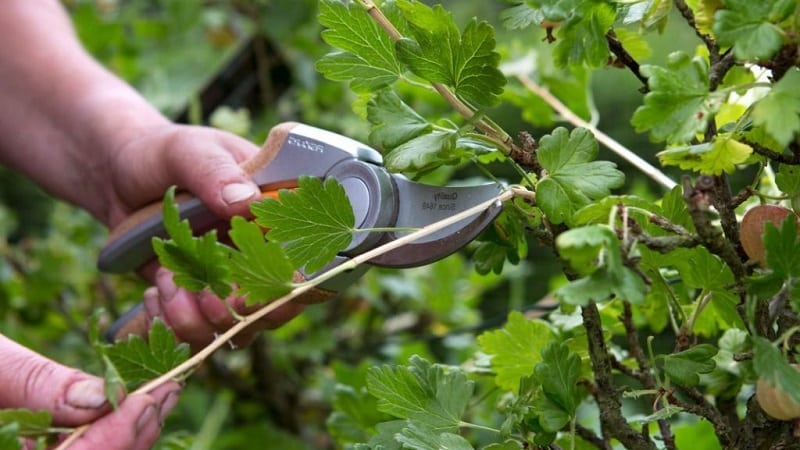
Gooseberries grow very quickly. Young branches grow actively, forming impenetrable thickets between themselves. On neglected and unkempt plants, the berries are small and their quantity is minimal. Ovaries are not formed because pollination is difficult. Over time, the plants stop bearing fruit altogether. If you do not prune, the plant becomes more susceptible to fungal diseases and pests.
Pruning in the spring is considered preventative, since the main formation of the crown is carried out in the fall.
In the first half of March they cut:
- dry, frozen or partially frozen branches (down to living tissue);
- shoots damaged by fungal diseases or harmful insects;
- twisted, frail and thin branches;
- growth at the root;
- shoots thickening the bush: horizontal, rubbing against each other and crossing;
- branches located too close to the ground or lying on it.
As a result of pruning, 4-5 of the strongest shoots are left, which are aligned in length. In this form, the plant will receive all the necessary nutrients and a sufficient amount of sunlight. In an unthickened crown, air circulates better - there is less chance of developing fungal diseases.
Attention! Small berries grow on plants that are too dense. A well-groomed bush produces large, juicy fruits.
Loosening
The soil under the gooseberry bushes is loosened to a depth of 5-7 cm. The soil is dug up to about 15 cm between the rows. The purpose of the event is to improve access of air, moisture and nutrition to the roots of the plant. To prevent weeds from taking nutrients from the berry bush, they are pulled out by hand and preferably with roots.
Reference. Often loosening is combined with fertilizing.
Watering
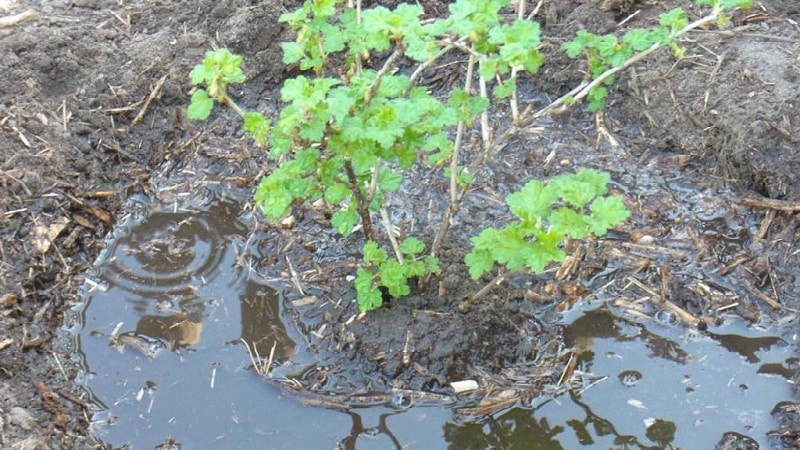
After the snow melts, the soil is well moistened, so at first there is no need for watering. Subsequently, the gooseberries are watered with water, the temperature of which coincides with the air temperature, in the morning or evening hours.
To prevent water from spreading, a furrow is made in the tree trunk circle. The event is carried out once a week, pouring 3-4 buckets of water under each adult bush. During the flowering period, the volume of water for irrigation is increased to 4-5 buckets.
Feeding
Fertilizing is an important activity that increases the yield of fruit crops.If planted correctly and the planting hole is fully filled with nutrients, the gooseberries are fed only after 2-3 years.
In early spring, fertilizers are applied according to the following scheme:
- The first time in April, during the period of swelling of the buds. If the plant is young, nitrogen substances are added to increase green mass - 40-60 g per bush. The granules are embedded in the soil along with the ashes.
- Adult crops are fertilized with better quality – organic and mineral substances. For one bush, prepare two buckets of the nutrient mixture. 20 g of superphosphate, 10 g of potassium and 10 g of urea are dissolved in one. In another - 1 kg of bird droppings or take slurry, which is also diluted with water.
- The second feeding is carried out during flowering. To do this, mix 5 kg of rotted manure, 20 g of potassium fertilizer, 5 kg of humus.
- The third time the plant is fed after flowering, watering it with mullein infusion. Fertilizer is mixed with water in a ratio of 1:5.
Mulching
To do this, use straw, peat, mown grass, sawdust or small shavings, and crushed tree bark. Mulch prevents weeds from developing and prevents the formation of excess root growth, and also retains moisture.
Treatment against diseases and pests
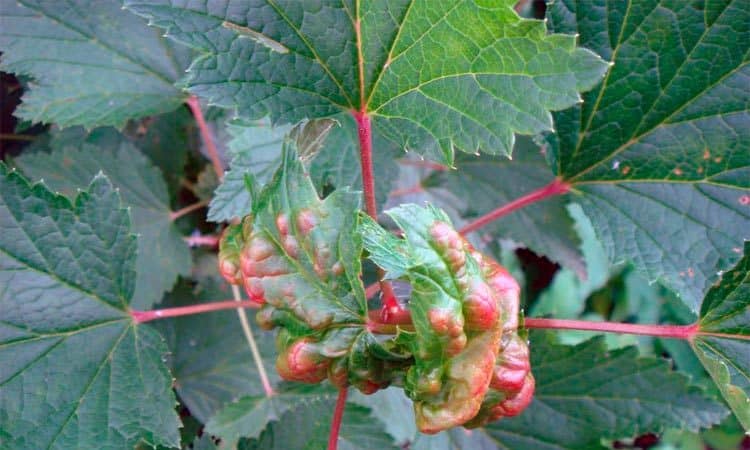
Gardeners often use an effective and simple treatment method - pouring hot water, almost boiling water, over the shoots from a watering can with a fine-mesh nozzle.
Under the influence of high temperatures, pathogens and pests that overwintered under the bark and buds of the plant die. The procedure is carried out in early spring and always with closed buds. They pour hot water not only on the bush, but also on the ground around it.
Gooseberries are plants with good immunity. But prevention of pests and diseases should not be neglected.
Diseases that sometimes affect gooseberries:
- white spotting;
- anthracnose;
- powdery mildew;
- mosaic.
The bush is also attacked by insects. The most common pest for berry plants is aphids.
First, they use harmless folk methods of control - they spray the plantings with garlic, tobacco, soap and soda, and onion infusions. If the means are ineffective, move on to more powerful means. For spring processing of gooseberries, biological or chemical preparations are used: Fitosporin, Fitoverm, HOM, Gaupsin, 1% Bordeaux mixture, 3% copper sulfate solution.
Transfer
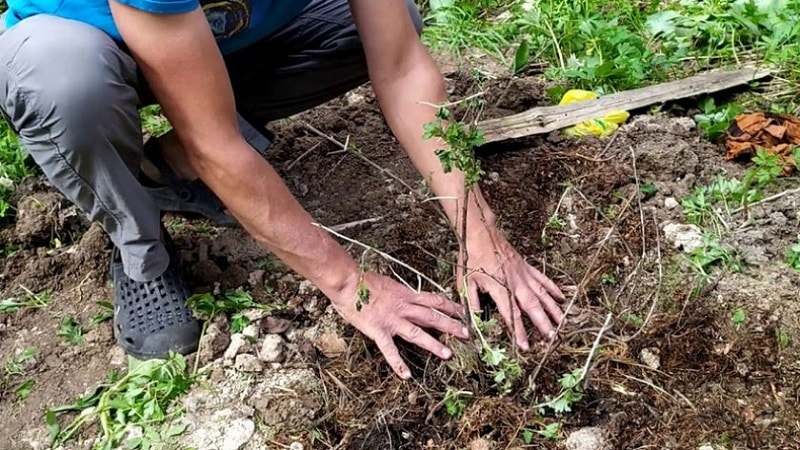
It is believed that autumn is the best time to transplant gooseberries, but this does not mean that the bushes cannot be replanted in spring or summer. It is advisable to do a spring transplant before sap flow begins and before the plant’s buds wake up.
Procedure:
- The bush is pruned.
- According to the diameter of the crown, the plant is dug to the depth of the roots (50-70 cm).
- Then, using a fork, the earthen ball with the rhizome is lifted and transferred to the prepared hole (50x50 cm), without shaking off the soil.
- The roots are inspected for the presence of larvae and spores, and the affected areas are sprinkled with ash.
- The new place is fertilized with humus and watered well.
- Next, the rhizome is placed in a hole, sprinkled with fertile soil, watered again and mulched.
Features of care depending on the region
Spring work on caring for gooseberries has its own nuances depending on the climatic characteristics of the region:
- In the south, events begin in early March.
- In the middle zone (Moscow region) work begins in the 1st-2nd decade of March, depending on weather conditions.Plant care consists of ordinary activities without any special features.
- In the north-west (in the Leningrad region), as well as in the Urals and Siberia, due to the long winter, spring gooseberry care is carried out in the 1st-2nd half of April and even early May. In the north, return frosts often occur, which destroy flowers. To avoid crop loss, experienced gardeners recommend monitoring the weather and, if necessary, covering young plants at night.
Different climatic conditions of the regions dictate to gardeners their own rules for growing gooseberries. They choose zoned varieties adapted for cultivation in a specific area, and in the northern regions they pay attention to frost-resistant gooseberries.
Spring planting gooseberries
In order for the seedling you like to take root well and soon delight you with a good harvest, a number of rules are followed.
When and how to plant
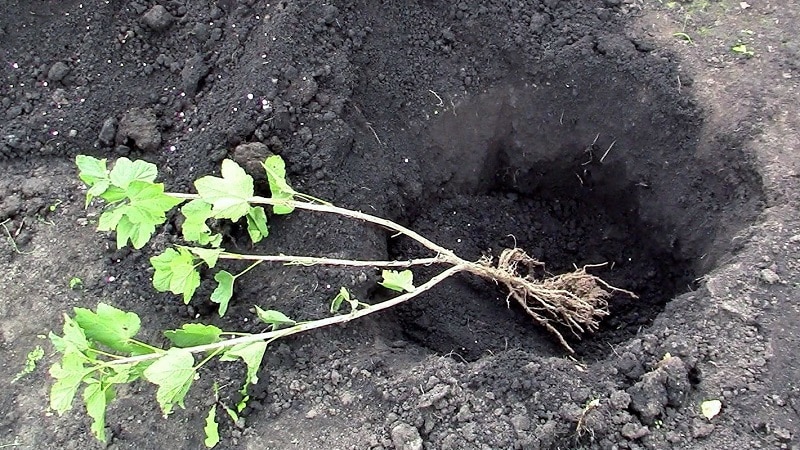
In different regions of the country, crop planting begins in accordance with the weather conditions of the area. The optimal time is before the buds open, while the plant is still dormant. If the seedling is purchased with a closed root system, that is, in a container, it can be planted later, even in summer.
When choosing gooseberry seedlings, carefully inspect and discard diseased and damaged plants. Preference is given to two-year-old bushes (they take root faster in a new place) and with an open root system, to make it easier to assess the condition of the plant. Gooseberries love the sun, so they grow well in an open and well-lit place.
Sequence of actions when landing:
- The young bush is trimmed, leaving 4 buds. This will allow the weakened roots to take root faster and provide nutrition to the above-ground part of the plant.
- The seedling is dipped in a 1% solution of potassium permanganate for disinfection.
- Inspect the root, get rid of dry and damaged roots and soak in a growth stimulator.
- Prepare a hole 50x50 cm.
- Pour rotted manure (10 kg/bush), wood ash (100 g), double superphosphate (50 g), and potassium sulfur (40 g) into it.
- Fertilizers are mixed with soil and a hill is formed at the bottom of the planting hole.
- A seedling is placed on it, the roots are carefully straightened and gradually covered with earth, compacting each layer. For good tillering, the root collar is deepened by 5-7 cm.
- Next, make a roller around the perimeter of the tree trunk circle 5-10 cm high to retain water, water (10 liters per bush) and mulch.
- After 3-4 days the procedure is repeated.
How to grow after planting
Further care of the young shrub is simple. It is watered in a timely manner, fertilized, the soil is loosened and pruned.
Features of growing on a trellis
The trellis method of cultivating gooseberries is becoming increasingly popular among gardeners. It cannot be called simple, but with certain care, the yield of the crop and its fruiting period significantly increases.
The trellis is convenient for picking berries and caring for the plantation, and ensures high quality harvest. The structure consists of wooden poles or metal pipes, between which wire is stretched in three rows.
How to grow gooseberries on a trellis:
- Seedlings are planted along the trellis, maintaining a distance of at least 1 m.
- A week after planting, the bushes are pruned: all shoots that grow to the side are removed, only strong, vertically growing ones are left and they are secured to the first level wire. The bush must have at least 4 branches.
- Every year, as they grow, the shoots are tied to the second and third wires.
- Young shoots formed near the root collar are removed.
Advice from experienced gardeners
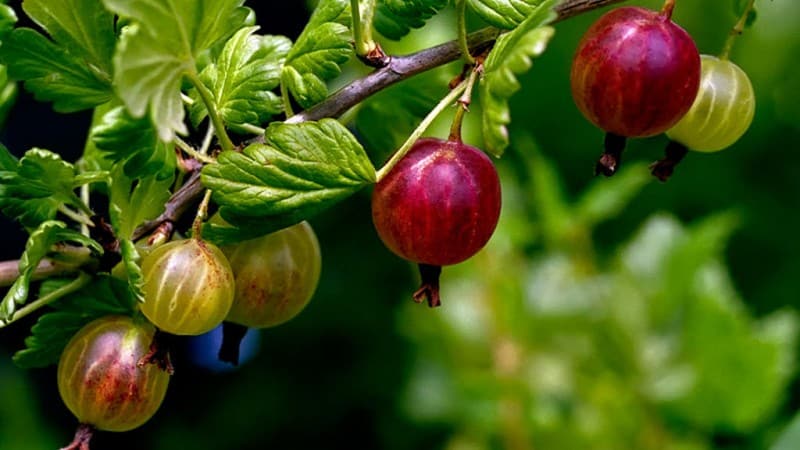
Experienced summer residents themselves adhere to the rules of planting and caring for gooseberries and give others advice on how not to harm the plant and get a decent harvest.
Mistakes to Avoid
Beginner gardeners sometimes make mistakes:
- The measures are carried out late, when sap flow has already begun and the buds have begun to swell.
- They do pruning incorrectly or ignore it, trying to preserve more shoots in order to increase the yield of the bush. This is a misconception.
- Apply excessive amounts of fertilizer or do not fertilize at all.
- Preventive treatments to protect gooseberries from pests and diseases are not carried out.
- Irrigate the bush from above when only root watering is needed.
- Peat is used as insulation, and it is a breeding ground for pests and their offspring. It is advisable to use it only in regions with harsh winters.
This is interesting:
How gooseberries propagate - all the ways
Sweet and juicy gooseberry variety Yubilyar
The sweetest and largest gooseberry: description of varieties
Conclusion
Planting gooseberries in a summer cottage will bring an excellent harvest if the gardener pays attention and makes efforts to care for the crop in the spring. After all, the further development of the plant depends on the correct implementation of spring procedures - pruning, watering and loosening, fertilizing, treatments against diseases and pests.